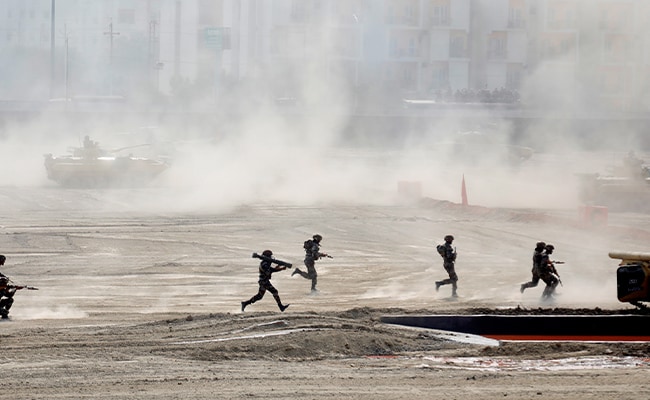2024-03-10 05:44:58

Indigenization to empowerment is a work in progress, Army chief said.
New Delhi:
The emergence of disruptive technology is transforming modern wars and blunting the conventional combat ratio which was a metric to determine the military strength and superiority between states, Army chief General Manoj Pande said at the maiden NDTV Defence Summit, highlighting some of the challenges in modern warfare.
Whether the use of tanks in World War 1 or the development of supersonic fighter jets after World War 2, ‘disruptive technology’ has changed the status quo between factions.
At the summit, General Pande focused on access to such technology by non-state actors, a challenge to the security of the country and said information, cyber, and space warfare have been added to the domain of conflicts. The Army chief said the adversary, with access to such technology, can initiate a low-threshold conflict.
Former Deputy National Security Advisor of the US, Nadia Schadlow said, “The space between war and peace is not an empty one – but a landscape churning with political, economic, and security competitions that require constant attention.”
– ‘Disruptive Technology’ –
The democratization of technology led to the easy acquisition of AI, which can be used to direct targeted attacks. The use of semi-autonomous and autonomous drones, which are powered by AI, in the Russia-Ukraine war and the attacks in the Red Sea have forced states to change their strategy. The US-led alliance in the Gulf is tracking the attacks but is yet to nip it in the bud.
Drones can carry out missions at low cost and have blunted the asymmetry. The US and UK are arming Ukraine with AI-powered drones to carry out precision strikes. Ukraine’s domestic production of drones has risen significantly since the war began in 2022 and the need has created a giant war lab and the country is producing more drones than it could purchase. The UK has increased the funding by 125 million pounds and will supply over 10,000 drones to Ukraine. Houthi rebels, backed by Yemen, have used autonomous platforms to target ships in the Gulf.

“The use of drones indicates a doctrinal shift and robots are here to play an important role. 10-15% of robots will be there in future forces,” Sameer Joshi, a defence expert said at the summit.
Off-the-shelf disruptive technologies have helped conventionally weaker states use methods to fight a cost-efficient, sustainable fight to stay on the battlefield longer. Israel’s Iron Dome air defence system uses AI to intercept incoming rockets. The 2021 Israeli offensive against Palestinians is called the first ‘AI war’ after Israel used AI tools like ‘Gospel’, ‘Alchemist’, and ‘Depth of Wisodm’ to conduct precision strikes on targets in Gaza.
Cyberattacks on state infrastructure through Malware have posed challenges for several years. The malware attack on the servers of AIIMS Delhi is one such example. The attack was by the Chinese, FIR details that the attack had originated from China. Of 100 servers (40 physical and 60 virtual), five physical servers were successfully infiltrated by the hackers.
Recently, healthcare providers in the US have struggled to make payments following a ransomware attack, which reportedly originated from Russia. The Colonial Pipeline attack on US oil infrastructure was the biggest in history. Reports claimed that a Russian group named DarkSide was responsible.
One of the key elements in India’s new criminal laws is the inclusion of “threat to economic security” under the definition of an “act of terror”.
Concerns over Deep Fakes have been raised even by Prime Minister Narendra Modi. Its use in information warfare in generating fake news, especially during a crisis. Information warfare is as essential as firepower in a battle to psychologically dominate the warring faction.
In November last year, US President Joe Biden signed an executive order outlining security measures for AI. The Deputy White House Chief of Staff Bruce Reed said Biden’s interest in AI was partly fuelled after watching Mission: Impossible – Dead Reckoning Part One.
The Army chief at the summit said, “This is happening amidst legacy challenges of unsettled borders continue,” – An indirect reference to issues with China and Pakistan.
– ‘China’s Three Warfare Strategy’ –
In 2003, the Chinese Communist Party’s Central Committee and the Central Military Commission approved the ‘Three Warfare Strategy’ to guide the People’s Liberation Army’s political and information warfighting. The three elements of the strategy are Public Opinion, Information and Legal Warfare.

Taking the border conflict in Ladakh as a reference, China used legacy claims like the 1962 reference line, and 1959 claims in Ladakh to justify its aggressive military posture. The dissemination of videos on social media related to the Galwan clash and standoff at other flash points was used to fight information warfare. Directing public opinion among its citizens that it’s our “lost land” and we have “sovereignty over it” were some tactics used. During Donald Trump’s Presidency, the US has raised concerns over China’s “Military-Civil Fusion” to develop technologies that have a dual use.
Such tactics, use of disruptive technology, and subterfuge have blurred the lines between peace and war and created a Grey zone conflict by the adversary, an issue highlighted by General Pande in his address.
– ‘Indigenization to Empowerment’ –
The Army Chief stressed the need to develop critical technologies indigenously to create a domestic ecosystem and reduce our reliance on foreign players. “A tri-services project is being undertaken to develop a high-powered computing AI cloud and a roadmap is being created,” General Pande said, adding that we are working on 45 niche technologies and 120 indigenous projects which have implications for the military.
“Swadeshikaran (Indigenization) se Sashakstikaran (empowerment) is a work in progress to be future ready, he said.
At the Innovation for Defence Excellence (IDEX), Defence Minister Rajnath Singh launched the ADITI scheme to accelerate innovation in critical and strategic deep-tech technologies for future warfare. It provides financial subsidies to private players, creating a public-private partnership model to develop future technology.
modern warfare,Army Chief General Manoj Pande,NDTV Defence Summit,Hybrid warfare,Grey zone conflict,AI,AI Drones,Chief of Army Staff (COAS) General Manoj Pande,Cyberattacks,drone warfare,Deepfakes
Source link
![]()



